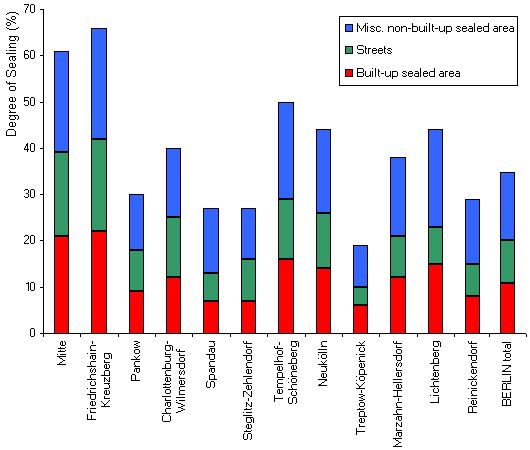The overall degree of sealing of Berlin is 34.7%, more than half of which is non-built-up (cf. Fig. 2). The stated “average degree of sealing” refers to the total area of a borough, or of the city as a whole, respectively. Moreover, the share of built-up area and the share of roadway surfaces in the total area of a borough is shown.
Treptow-Köpenick has the lowest degree of sealing among the boroughs, with 19%, while Friedrichshain-Kreuzberg and Mitte are the boroughs with the highest degrees of sealing, 68 and 61%, respectively. The share of built-up areas is also highest in these boroughs.
The relationship between built-up, non-built-up and roadway surfaces comes to one fifth each of the total area in the inner-city boroughs, while for the outlying areas, the non-built-up sealed share is considerably higher than that of the built-up areas, which is in turn higher than that of the roadway surfaces.
The highest degrees of sealing appear within the urban-rail ring line in the old residential buildings. Residential areas which still have predominantly closed dooryards show degrees of sealing of more than 90%. But the major industrial and commercial districts are also sealed to a high degree. Particularly the areas of long-standing industrial us along the Spree from Spandau to Köpenick, and the extensive industrial areas in Lichtenberg, Marzahn and Hohenschönhausen are more than 90% sealed
Overall the degree of sealing drops as one moves from the center toward the outskirts. This corresponds to the fact that the density of buildings is reduced toward the outskirts, and these outskirts are either completely undeveloped (woods, farmland), or characterized by detached housing. Certain exceptions stand out: The traditional centers of cities like Spandau and Köpenick, which were independent until 1920, are more than 60% sealed, climbing to over 90% sealed in their core areas. The major new development areas in the outskirts, such as Marzahn, Hellersdorf and Hohenschönhausen, Gropiusstadt in Rudow, or the Thermometer District in Lichterfelde, are between 50% and over 80% sealed.

